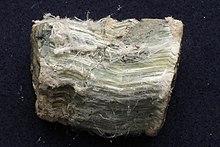
Back Chrisotiel Afrikaans أسبست السيربنتين Arabic ক্রাইসোটাইল Bengali/Bangla Crisòtil Catalan Chrysotil German Crisotilo Spanish Krisotilo Basque کریزوتیل Persian Krysotiili Finnish Chrysotile French
| Chrysotile | |
|---|---|
 | |
| General | |
| Category | Phyllosilicates Kaolinite-serpentine group |
| Formula (repeating unit) | Mg3(Si2O5)(OH)4 (ideal) |
| IMA symbol | Ctl[1] |
| Strunz classification | 9.ED.15 |
| Crystal system | Monoclinic: clinochrysotile (most common) Orthorhombic: orthochrysotile and parachrysotile (both rare) |
| Crystal class | Clinochrysotile: prismatic (2/m) Orthochrysotile and parachrysotile: pyramidal (mm2) |
| Space group | Clinochrysotile: C2/m Orthochrysotile and parachrysotile: Ccm21 |
| Identification | |
| Formula mass | 277.11 g/mol (ideal) |
| Colour | White to greyish green |
| Crystal habit | Acicular |
| Fracture | Fibrous |
| Mohs scale hardness | 2.5–3 |
| Lustre | Silky |
| Streak | White |
| Diaphaneity | Translucent |
| Density | 2.53 g/ml |
| Optical properties | Biaxial (+) |
| Refractive index | nα = 1.569, nγ = 1.570 |
| Birefringence | 0.001 (max) |
| Dispersion | Relatively weak |
| Extinction | parallel |
| Melting point | 600–850 °C (1,112–1,562 °F) (decomposes) |
| Fusibility | dehydrates at 550–750 °C (1,022–1,382 °F) |
| Diagnostic features | White to grayish green thin, flexible curved fiber |
| Solubility | Insoluble in water Fibres degrade in dilute acid |
| References | [2][3][4] |
Chrysotile or white asbestos is the most commonly encountered form of asbestos,[5] accounting for approximately 95% of the asbestos in the United States[6] and a similar proportion in other countries.[7] It is a soft, fibrous silicate mineral in the serpentine subgroup of phyllosilicates; as such, it is distinct from other asbestiform minerals in the amphibole group. Its idealized chemical formula is Mg3(Si2O5)(OH)4.[5] The material has physical properties which make it desirable for inclusion in building materials, but poses serious health risks when dispersed into air and inhaled.
- ^ Warr, L.N. (2021). "IMA–CNMNC approved mineral symbols". Mineralogical Magazine. 85 (3): 291–320. Bibcode:2021MinM...85..291W. doi:10.1180/mgm.2021.43. S2CID 235729616.
- ^ Mineralienatlas
- ^ Chrysotile on Mindat.org
- ^ Chrysotile data on Webmineral
- ^ a b "Asbestos" (PDF). Report on Carcinogens, Eleventh Edition. U.S. Department of Health and Human Services. 2005.
- ^ Occupational Safety and Health Administration, U.S. Department of Labor (2007). 29 C.F.R. 1910.1001. Appendix J.
- ^ Institut national de recherche sur la sécurité (1997). "Amiante Archived 2008-06-25 at the Wayback Machine." Fiches toxicologiques. n° 167. (in French)